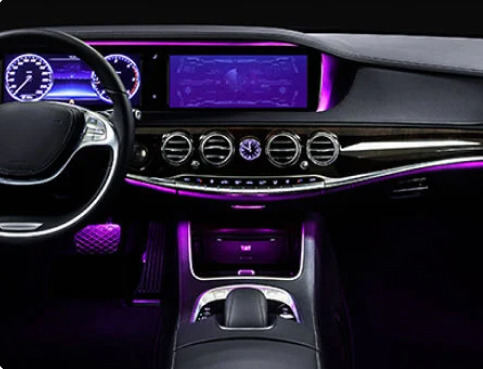The transformative power of lighting and power-delivery solutions
By Michael Wittmann, Senior VP of Marketing
From the incredible leaps forward in driver assistance and vehicle safety to the ever-increasing adoption of all-electric vehicles, there are a growing number of areas where advanced semiconductors are underpinning the rapid evolution of automotive technology (Autotech). However, today’s vehicles aren’t just about getting from A to B safely or in the most environmentally sustainable manner. Thanks, at least in part, to expectations set by consumer devices and the performance, ease-of-use, functionality, and customization they now offer, drivers and passengers also demand an equivalent level of rewarding user experience while they are in their vehicle.
In response to this demand, auto manufacturers have shifted vehicle advertising away from performance and horsepower and are refocusing on convenience, electrification, and a more modern in-cabin experience. And by looking at a vehicle beyond being a functional tool for travel, we see the emergence of an immersive in-cabin environment, where passengers engage in communication, entertainment, and information sharing – in effect a temporary home and, for many, a temporary workplace. In this view, we see the powerful role intelligent interior electronics design can play in delivering the best possible user experience (UX) throughout the cabin.
Immersive UX Through Intelligent Lighting
Lighting has always been a fundamental aspect of vehicle design. However, in modern automobiles, in-cabin lighting goes beyond a functional or safety necessity and is critical for enhancing the UX of vehicle occupants and developing a positive association with the automotive brand. This is perhaps best exemplified by Audi, with their statement that “lighting visualizes the brand’s core values – progressiveness, sportiness, and sophistication to a great extent”[1].
The contribution that lighting can make to our well-being is well understood by architects and interior designers creating living and work spaces. Warm and cool lighting, for instance, goes far beyond simply creating a visual impression and can be employed in different ways to engender different feelings. Now that same thinking is being applied to improve the experience for drivers and passengers and create everything from a sense of orientation and a feeling of spaciousness to a more relaxing and less stressful driving environment. Additionally, the ability to configure and modify ‘mood lighting’ with respect to hue, tint, tone, shade, and intensity allows drivers to personalize their vehicles to suit their style, preference, emotional state, or nature of the drive itself.
The ability to provide automotive designers with more options and form factors for lighting placement throughout the vehicle has opened a door for advanced LED technologies and smart lighting systems. These advancements benefit not only interior cabin lighting and instrument illumination but external vehicle lighting including headlights and rear lights.
Supporting these sophisticated LED solutions requires advanced LED controllers, such as the iND83211 driver for intelligent lighting systems shown in Figure 1. This device replaces multiple components with a highly integrated, ultra-compact MCU-based single-chip solution.
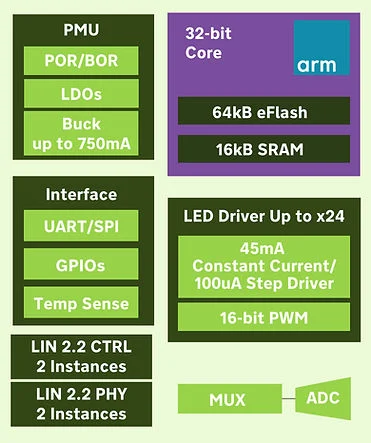
Requiring minimal external components and designed to drive LEDs efficiently and accurately at their maximum luminous output without exceeding safe operating conditions, the iND83211 features an integrated 32-bit Arm® Cortex® M0 processor, with 64kB of Flash and 16kB of SRAM. Unique to this IC is a built-in power management unit that implements a step-down buck converter and two on-chip voltage regulators. This is the key to creating a small form factor, high-power, and flexible power management system capable of driving 24 LEDs or 8 x RGB channels. The device can also be used to drive fewer LEDs at higher currents to create LED ‘light pipes’ that transport light from an LED source to where it is needed – a feature that is becoming increasingly popular in newer vehicles. And because the IC can withstand a 40V load dump from the car battery, it can be connected directly to the automotive supply, further minimizing the need for additional components.
On-the-Move Communication, Entertainment, and Information
Expectations regarding access to communication, entertainment, and information on the move are changing as the seamless integration of mobile devices within the automotive environment becomes as important as the built-in infotainment systems. As a result, providing interfaces between these two technologies is now an important element of intelligent cabin design and a holistic user experience. That means implementing systems such as Apple CarPlay that allows occupants to safely use mobile devices to make calls, send and receive messages and enjoy their favorite music, and also providing the USB-based power delivery (USB-PD) infrastructure to support the often simultaneous in-cabin charging for mobile phones as well as higher power devices such as tablets and laptops.
indie Semiconductor is the leading provider of solutions for Apple CarPlay, USB hubs, and power delivery. Most recently the company has been developing advanced semiconductor solutions that simplify in-cabin fixed and wireless charging of portable devices – including the new iND87300, the automotive industry’s most integrated USB-PD firmware programmable controller (Figure 2).
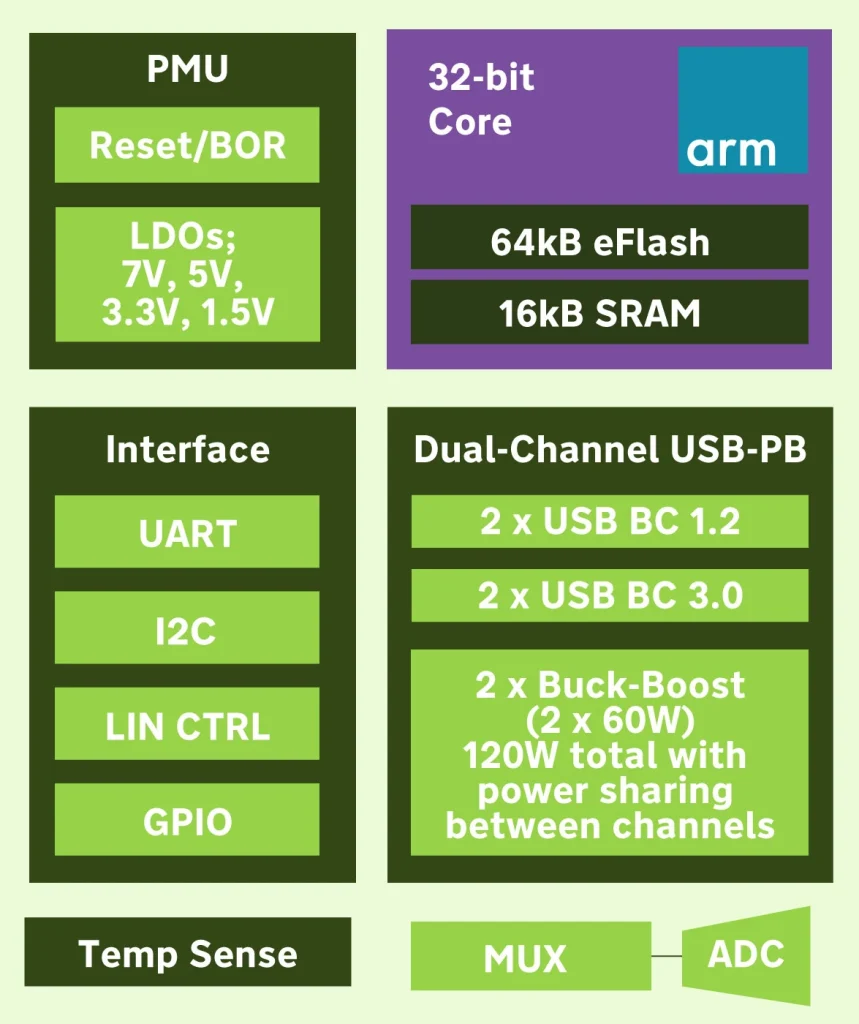
Enabling system efficiency above 95%, the iND87300 integrates a buck-boost converter and an Arm® Cortex® M0 core processor that allows vendor-specific configurations as well as field upgrades and over-the-air (OTA) updates that ensure future compatibility with new and emerging charging protocols. The output voltage is programmable between 3.3V and 21V and the device can deliver up to 60W of output power per channel with a maximum current of 5A.
Automotive-Qualified Reference Designs Speed Evaluation and Prototyping
To enable automotive OEMs and Tier 1 manufacturers to speed the development of next-generation lighting and in-cabin device charging applications, indie has developed a series of advanced end application-based reference designs. These incorporate all the elements needed to evaluate likely system performance in a real-life scenario and require little additional effort to implement OEM-compliant solutions. To date, the customer feedback for these reference designs has been incredible, with many confirming that the comprehensive nature of the design helped them to rapidly explore a variety of possibilities and reduce overall project development time.
In the case of lighting, for example, the iND83211 automotive grade reference design shown in Figure 3 is a fully functional module based on a single, high-power RGB LED and provided in a mechanical package comparable to a final series production solution.
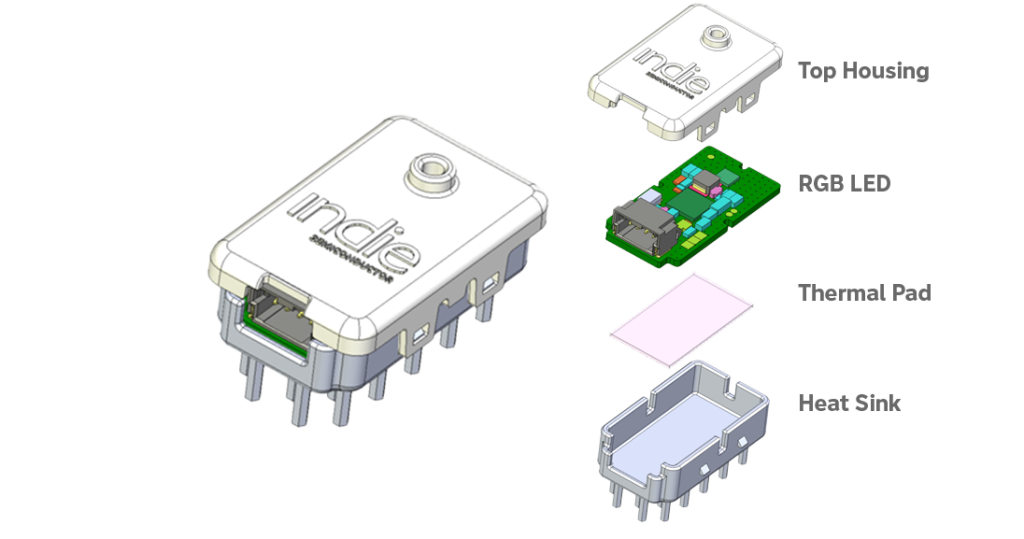
Field-programmable via a LIN interface, the design features proven, built-in EMC and thermal mitigation and an internal MCU that controls all system functions – for most applications no additional programming is required. Unlike a traditional linear LED driver that can become thermally unmanageable when driving higher-power LEDs, indie’s technology, with its integrated buck regulator, intelligently and efficiently reduces battery voltage to minimize heat and maximize LED brightness.
For high-power, dual-channel USB-PD applications, indie has created an advanced reference design built around the recently announced iND87300 chip (Figure 4).
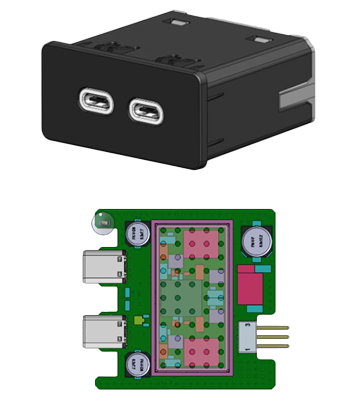
As with the lighting reference design, this is provided in a mechanical package comparable to a final production solution and has been specifically developed to address key system design challenges of thermal and system efficiency, power sharing, and EMC compliance.
Finally, it is worth noting that there has been a growing demand from Tier 1 and OEM customers for embedded solutions such as lighting and power delivery that can support greater flexibility and provide performance and feature future-proofing without compromising power and cost goals. In part, this is a response to the recent supply shortages, but it also reflects the reality that vehicle architectures are in flux, and a one-size approach does not fit all. Distributed intelligence – enabled in the case of indie technologies described in this Blog through the addition of the embedded Arm Cortex M0 – provides OEMs and Tier 1s with the ability to meet the needs of their differing platforms.
Delivering User Experience – Technology and Support
As a company that is completely focused on developing best-in-class technologies for automotive applications, indie Semiconductor is actively involved in helping a growing number of automotive OEMs and Tier 1s deploy intelligent designs that enhance the user experience for vehicle occupants. Alongside advanced technologies for vehicle lighting, power delivery, and device charging, the company offers solutions for device-to-IVI connectivity that seamlessly integrate portable technologies into the in-cabin environment and deliver the functionality and performance that users take for granted with consumer electronics products.
But our capabilities don’t start and end with the technology. To ensure that our customers can create the best possible UX solutions in the shortest possible time we offer comprehensive and local design engineering and application support from a team of industry specialists based at regional Centers of Excellence (CoEs) all over the world.
